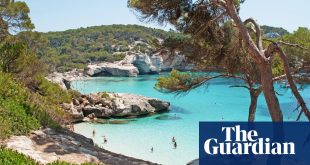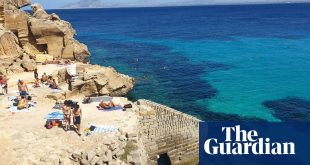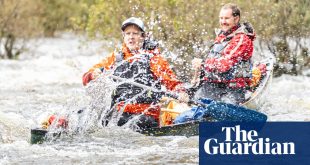Alfred Wainwright’s coast-to-coast trail through Cumbria and North Yorkshire over mountains and moorland is one of the UK’s most popular long-distance walks, with an estimated 6,000 people completing the whole 197 miles each year, and lots more walking shorter sections. In August 2022 the government announced it would become England’s newest national trail. About the same time, the Borrowdale Royal Oak hotel in Rosthwaite, near Derwentwater and right on the route, reopened after a £1.3m refurbishment with a sustainable focus (and free cake).
The Lake District has excellent public transport compared with most of rural England so I head to Rosthwaite and back by train, bus, boat and foot. The eight miles of the trail between Borrowdale and Grasmere are considered a scenic highlight. Wainwright, a celebrated writer and fell walker in the postwar period, describes one stretch nearby as “a walk in heaven”.
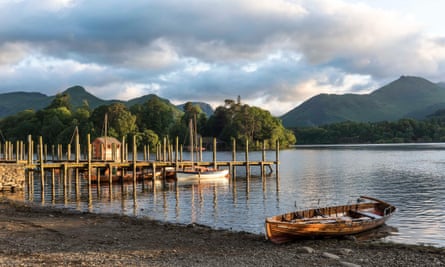
Day one is idyllic. I meet a friend at Euston station in London and for the direct three-hour ride north to Oxenholme. The train to Windermere is waiting on the opposite platform. On arrival we stock up at Booths, a grocery store by Windermere station, jump on one of the frequent buses to Bowness, and spend the afternoon cruising around England’s biggest lake on a 19th-century boat, toasting the sunshine with a pint of Wainwright Gold.
Leaving the boat at Ambleside, we settle into YHA Ambleside in an old lakeside hotel by the pier, and take an evening stroll through nearby woods to prepare for our big hike the next day. Swallows are darting and swooping over the ruins of Galava Roman fort, 10 minutes’ walk from the hostel as we climb up through Skelghyll Wood, past glades of ferns and fields of Herdwick lambs.

Next morning, the open-topped 599 takes us to Grasmere on one of the UK’s best bus rides. We pass Bridge House, straddling the stream at Ambleside, the gentle shores of Rydal Water, whitewashed Dove Cottage and other Cumbrian landmarks. Grasmere smells of woodsmoke and melting sugar.
Half a mile from the churchyard where William Wordsworth is buried, we call in at Allan Bank (entry: £7), where the poet and his family moved from Dove Cottage in 1808. Hardwicke Rawnsley, one of the founders of the National Trust, lived here a century later. The house is now a welcoming space of books and murals, where you can help yourself to tea and sit by the fire. A red squirrel leaps from branch to branch as we set off again through intermittent Lake District drizzle.
Legs aching, we stop to eat honey-spiced Grasmere gingerbread, and admire the view from Helm Crag: the sunlit green of the village and wooded lake is framed by cloud-capped hills. The interminable steps and scrambles that led up here felt like the stairs of Cirith Ungol that JRR Tolkien’s hobbits had to scale to reach Mordor. As we carry on up past Gibson Knott, the views get even better and the paths get worse with knee-deep quagmires and ankle-ricking rocks. The £5.6m budget for upgrading this route to National Trail standard by 2025 begins to look optimistic.
A group of walkers is heading towards us, exhausted and bedraggled despite their state-of-the-art hiking gear.
“How are the paths ahead?” I ask nervously, “we’re heading for Rosthwaite.”
“You’ll never make it,” says their leader bluntly. “We left there six and a half hours ago. It’s a long scramble down Lining Crag and, if it starts to rain, you’re in trouble.”
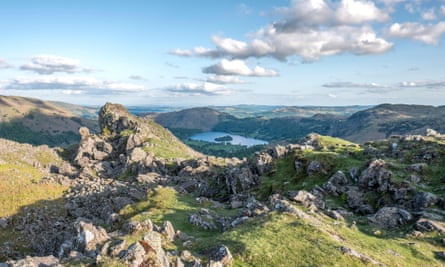
An hour later, after more laborious climbing, it does start to rain. The dark, forbidding ramparts of Greenup Edge and the crags beyond loom into even darker clouds. Thomas West, who wrote one of the earliest Lake District guidebooks, describes it as “that turbulent chaos of mountain behind mountain”. A rough path leads sharply left down Far Easedale and, with a mix of disappointment and relief, we turn back along it towards Grasmere. It’s a steep streamside walk and it’s late afternoon by the time we get back to where we started.
after newsletter promotion
But we’re saved by that great public transport. Bus 555 is another chart-topping scenic journey, whisking us past showery Thirlmere and Helvellyn to Keswick, where bus 78 sets off for Seatoller via Rosthwaite every 30 minutes until 6.20pm, and stopping almost outside the Royal Oak.
The hotel has been a slate miners’ tavern, an auction house and a temperance hall; it has hosted tea parties and wrestling matches’; and now it’s a tasteful place to stay, with cosy lounges and a hi-tech drying room that sorts out my sodden boots. Unlike Wordsworth, who had to share his bed with a Scottish pedlar when he stayed here, we have a comfortable bed each. The fresh daily menu is the feast we’ve been waiting for after a day in the fells, from squid in a deeply tomato-y fennel and chorizo stew to a rich, dark sticky toffee pudding (three courses £35).

Next day, we walk a few blissfully low-level miles to Lodore Falls, past caves and old quarries and crab apple trees. We cross Derwentwater in style on one of the brass-trimmed mahogany boats of the Keswick Launch Company, singles from £2.75. St Herbert’s Island, familiar from the cover of the British Pilgrimage Trust’s new book , was the model for Beatrix Potter’s Owl Island of Squirrel Nutkin fame. It’s a perfect wooded dome, with the overgrown ruins of Saint Herbert’s cell hidden near the stony shore.
After a walk to Friars Crag and some souvenir shopping, our last bus ride is another Cumbrian classic. The X4/X5 from Keswick to Penrith passes rivers and whitewashed cottages, drystone-walled pastures and bare, receding hills, where rays of light come down in shafts through lowering clouds.
At Penrith station, with its bookshop and community gardens, we find our train is cancelled. Steve, one of the station’s exemplary staff, recommends a local pub and soon comes to find us there to tell us an extra train is stopping in 20 minutes. With Lake District views out of one window and the Yorkshire Dales from the other, we end our 100-mile loop through Cumbria with fields and fells drenched in golden light – and a celebratory drink from the trolley.
The Borrowdale Royal Oak has doubles from £100 B&B; YHA Ambleside has private rooms sleeping three from £50. Advance tickets from London Euston to Penrith start at £32 (fastest journey three hours) or £10.10 for Glasgow to Penrith (one and a half hours). Cumbria Tourism helped organise the trip
 Top Naija News: Nigerian News, Breaking News Nigeria and World News Top Naija News is a daily news publication in Nigeria, delivering the latest breaking news in Nigeria and around the world.
Top Naija News: Nigerian News, Breaking News Nigeria and World News Top Naija News is a daily news publication in Nigeria, delivering the latest breaking news in Nigeria and around the world.
